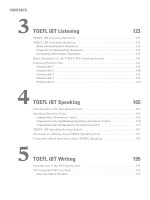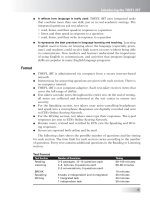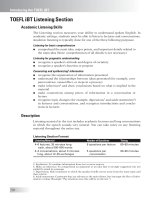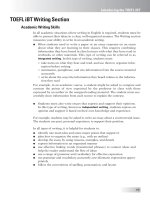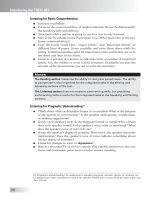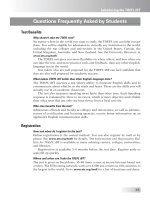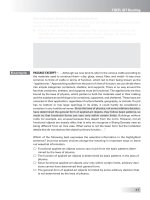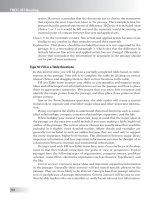The official guide to the toefl ibt third edition part 45 doc
Bạn đang xem bản rút gọn của tài liệu. Xem và tải ngay bản đầy đủ của tài liệu tại đây (80.22 KB, 7 trang )
Listening
Answer Key and Self-Scoring Chart
Directions: Check your answers against the Answer Key below. Write the number
1 on the line to the right of each question if you picked the correct answer. (For
questions worth more than one point, follow the directions given.) Total your
points at the bottom of the chart.
Question Number Correct Answer Your Raw Points
1. 2 ______
2. 1, 3 ______
3. 4 ______
4. 2 ______
5. 3 ______
6. 4 ______
7. 3 ______
8. 1 ______
9. 1, 3 ______
10. 3 ______
11. 1 ______
12. 3 ______
13. 3, 4 ______
14. 4 ______
15. 1 ______
16. 2 ______
17. 4 ______
18. 1 ______
19. 2 ______
20. 2, 3 ______
For question 21, write 2 if you placed three answer choices correctly. Write 1 if
you placed two choices correctly.
21. Yes: 2, 3
No: 1 ______
22. 1 ______
23. 1 ______
24. 3 ______
25. 1 ______
26. 2 ______
27. 3 ______
28. 4 ______
299
Answers, Explanations, and Listening Scripts
Question Number Correct Answer Your Raw Points
29. 2 ______
30. 2 ______
31. 3 ______
32. 1 ______
33. 2 ______
For question 34, write 2 if you placed three answer choices correctly. Write 1 if
you placed two choices correctly.
34. Functional: 1, 3
Project: 2 ______
TOTAL: ______
On the next page is a table that converts your Listening Practice section answers
into a TOEFL iBT Scaled Score. Take the number of correct answers from your
Answer Key table and find that number in the left-hand column of the table. On
the right-hand side of the table is a range of TOEFL iBT Listening scores for that
number of correct answers. For example, if the total of points from your answer
key is 27, the table says your estimated TOEFL iBT Listening section scaled score
is in the range of 22 to 24. Your scaled score is given as a range instead of a sin-
gle number for the following reasons:
b
The estimates of scores are based on the performance of students who
participated in a field study for these listening comprehension questions.
Those students took the test on computer. You took your practice test by
listening to audio tracks and answering questions in a book. Although the
two experiences are comparable, the differences make it impossible to
give an exact prediction of your score.
b
The students who participated in the field study were volunteers and may
have differed in average ability from the actual TOEFL test-taking popu-
lation.
b
The conversion of scores from the field study in which these questions
were administered to the current TOEFL iBT scale involved two scale con-
versions. Converting from one scale to another always involves some sta-
tistical error.
b
You should use your score estimate as a general guide only. Your actual
score on TOEFL iBT may be higher or lower than your score on the prac-
tice section.
300
TOEFL iBT Practice Test 1
Listening
301
Answers, Explanations, and Listening Scripts
Raw Point Total Scale Score
36 28–30
35 28–30
34 28–30
33 28–30
32 27–29
31 26–29
30 25–27
29 25–27
28 24–26
27 22–24
26 21–23
25 21–23
24 17–22
23 16–21
22 16–21
21 16–18
20 14–18
19 13–17
18 13–17
Raw Point Total Scale Score
17 11–16
16 10–15
15 10–15
14 9–13
13 8–12
12 6–12
11 4–10
10 3–10
9 0–9
8 0–9
7 0–7
6 0–5
5 0–3
4 0–3
3 0–3
2 0–3
1 0–3
0 0–3
Listening Scripts and Answer Explanations
Questions 1–5
Track 11 Listening Script
Narrator
Listen to a conversation between a student and a professor.
Professor
Hey, Ellen. How are you doing?
Student
Oh, pretty good, thanks. How are you?
Professor
OK.
Student
Did you, um, have a chance to look at my grad school application . . . you know, the
statement of purpose I wrote.
Professor
Well, yeah. In fact, here it is. I just read it.
Student
Oh, great! What did you think?
Professor
Basically, it’s good. What you might actually do is take some of these different points
here, and actually break them out into separate paragraphs. So, um, one: your pur-
pose for applying for graduate study; uh, why do you want to go to graduate school,
and an area of specialty; and, uh, why you want to do the area you’re specifying; um,
and what you want to do with your degree once you get it.
Student
OK.
Professor
So those are . . . they’re pretty clear on those four points they want.
Student
Right.
Professor
So, you might just break them out into uh . . . you know, separate paragraphs and ex-
pand on each point some. But really what’s critical with these is that, um, you’ve gotta
let yourself come through. See, you gotta let them see you in these statements. Ex-
pand some more on what’s happened in your own life and what shows your . . . your
motivation and interest in this area—in geology. Let ‘em see what really, what . . .
what captures your imagination about this field.
302
TOEFL iBT Practice Test 1
Student
OK. So make it a little more . . . personal? That’s OK?
Professor
That’s fine. They look for that stuff. You don’t wanna go overboard . . .
Student
Right.
Professor
. . . but it’s critical that . . . that somebody sees what your passion is—your personal
motivation for doing this.
Student
OK.
Professor
And that’s gotta come out in here. Um, and let’s see, uh, you might also give a little,
uh—since this is your only chance to do it, you might give a little more explanation
about your unique undergraduate background. So, you know, how you went through,
you know, the music program; what you got from that; why you decided to change. I
mean, it’s kind of unusual to go from music to geology, right?
Student
Yeah. I was . . . I was afraid that, you know, maybe the personal type stuff wouldn’t be
what they wanted but . . .
Professor
No, in fact it’s . . . um, give an example: I . . . I had a friend, when I was an undergrad,
um, went to medical school. And he put on his med school application—and he could
actually tell if somebody actually read it ‘cause, um, he had asthma and the reason
that he wanted to go to med school was he said he wanted to do sports medicine
because he, you know, he had this real interest. He was an athlete too, and . . . and
wanted to help athletes who had this physical problem. And he could always tell if
somebody actually read his letter because they would always ask him about that.
Student
. . . Mmm . . . so something unique.
Professor
Yeah. So see, you know, that’s what’s good and and I think for you probably, you
know, your music background’s the most unique thing that you’ve got in your record.
Student
Right.
Professor
. . . Mmm . . . so you see, you gotta make yourself stand out from a coupla hundred
applications. Does that help any?
Student
Yeah, it does. It gives me some good ideas.
303
Answers, Explanations, and Listening Scripts
Professor
And . . . what you might also do too is, you know, uh, you might get a friend to proof it
or something at some point.
Student
Oh, sure . . . sure.
Professor
Also, think about presentation—how the application looks. In a way you’re actually
showing some other skills here, like organization. A lot of stuff that’s . . . that they’re
not . . . they’re not formally asking for, they’re looking at. So your presentation format,
your grammar, all that stuff, they’re looking at in your materials at the same time.
Student
Right. OK.
Answer Explanations
1.
ᕢ
For Listening conversations that take place in a professor’s office hours, it
is very likely that the first question will be a Gist-Purpose question. That is the
case here. This discussion is about how the woman should write her graduate
school application, not about an interview or whether or not she had been
admitted. The professor already has her application and has reviewed it, so
the purpose cannot be for her to give him the application. Thus choice 2 is the
correct answer; she wants advice about the application.
2.
ᕡ ᕣ
When you are taking the TOEFL iBT test on computer, whenever you
see squares in front of the question choices instead of ovals, you should rec-
ognize that the question calls for you to select two or more answers from
among the choices. In this case, the professor stresses the following two items
that the woman needs to include in her application letter:
1. How her college career has made her interested in graduate school
2. How she stands out as an individual
Thus the correct answers are choices 1 and 3. She does not have a back-
ground in medicine (choice 2), and the professor does not mention her teach-
ers (choice 4).
3.
ᕤ
This is a Detail question. The professor mentions twice that the woman’s
decision to go from studying music to geology is unusual.
4.
ᕢ
This is an Understanding the Function of What Is Said question. Clearly
the professor is illustrating his point that a good application should individu-
alize the writer. His friend who went to medical school is an example.
5.
ᕣ
This is a Making Inferences question. The last thing the professor mentions
to the student is that she should think about the format of her application and
the statement of purpose. He says that the format of the application can
demonstrate her organizational skills and strongly implies that avoiding any
writing errors shows thoroughness. By making these points, he is implying
304
TOEFL iBT Practice Test 1
that the readers of the application will be influenced by its appearance, even
if the influence is unconscious. He says nothing about the readers’ expertise
(choice 1); he implies that sometimes they may not read the application care-
fully, but he does not imply that this is what usually happens (choice 2); and
he says the opposite of choice 4. The correct answer is choice 3.
Questions 6–10
Track 12 Listening Script
Narrator
Listen to part of a conversation between two students. The woman is helping the man
review for a biology examination.
Male Student
OK, so . . . what do you think we should go over next?
Female Student
How about if we go over this stuff about how bacteria become resistant to antibiotics.
Male Student
OK.
Female Student
Um, but first of all, though, how many pages do we have left? I told my roommate I’d
meet her at the library at seven o’clock.
Male Student
Ummm . . . There’s only a few pages left. We should be finished in a few minutes.
Female Student
OK. So, ummm . . .
Male Student
About how bacteria become resistant to antibiotics.
Female Student
Oh yeah, OK. So you know that some bacteria cells are able to resist the drugs we use
against them, and that’s because they have these special genes that, like, protect them
from the drugs.
Male Student
Right. If I remember correctly, I think the genes like . . . weaken the antibiotics, or like
. . . stop the antibiotics from getting into the bacteria cell, something like that?
Female Student
Exactly. So when bacteria have these genes, it’s very difficult for the antibiotics to kill
the bacteria.
Male Student
Right.
305
Answers, Explanations, and Listening Scripts

